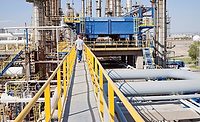Suiting Up with Al-Mg-Si for Corrosion Resistance

Although steel is widely used in industry, its low corrosion resistance limits the life of the equipment and hinders certain applications such as shipping and implementation of marine technologies. Now, researchers from the Korea National Ocean and Maritime University have developed a new aluminum-magnesium-silicon (Al-Mg-Si) alloy that can greatly increase the corrosion resistance of steel.
One of the most common methods of improving the corrosion resistance of steel is coating it with other metals such as aluminum (Al). But the use of Al in marine applications is limited owing to its tendency to react with chloride ions in sea water, leading to corrosion. The addition of other elements, such as magnesium (Mg) and silicon (Si), to form an alloyed coating is a promising way around this problem. But Mg cannot be easily deposited as a coating using the conventional method of dipping the steel into a hot bath of metal salts.
In a recent study published in Corrosion Science, scientists have developed a new protocol for Al-Mg-Si coating of steel. “When I served in the navy, I was constantly looking at rusting machinery. Since then, I have become fully engaged in research on how to produce better anti-corrosive steels,” says Professor Myeong-Hoon Lee of the Korea National Maritime and Ocean University, who guided the study. This study was made available online on September 9, 2021 and was published in Volume 192 of the journal in November 2021.
In this study, the researchers took aluminized steel (with Al and Si) and then plated it with Mg using a technique called “physical vapor deposition.” This was then followed by exposing the coating to a high temperature of 375 °C. They then characterized the coating film and performed corrosion testing in the form of a “salt spray test.” They found that the corrosion products were also formed in two layers: a surface layer made of primarily Al-based corrosion products, and an inner corrosion layer made of Al-, Mg- and Si-based products. Moreover, the inner layer of corrosion products produced a “shielding effect,” which further improved their anti-corrosion properties.
“Our research reveals how a highly corrosion-resistant steel can be produced using a simple change in the surface treatment protocol. This makes it very meaningful for conserving energy and environmental resources,” explains Prof. Lee.
This new protocol for enhanced corrosion resistance in steel takes a bold but sure step towards a more sustainable future.
Reference
Authors: Gi-DongPark1*, Ji HoonYang2, Kyung-Hwang Lee2, Hyo-Jin Kim1, Seung-Hyo Lee3, Jun Kang1, Yong-Sup Yun1 and Myeong-Hoon Lee1*
Title of original paper: Ultra-high corrosion resistance of Al-Mg-Si film on steel sheet formed by PVD Mg coating and heat treatment
Journal: Corrosion Science
DOI: https://doi.org/10.1016/j.corsci.2021.109829
Affiliations:
-
Division of Marine System Engineering / Interdisciplinary Major of Maritime AI Convergence, Korea Maritime & Ocean University, Republic of Korea
-
Materials Performance Research Group, POSCO Steel Solution Research Lab., POSCO Global R&D Center, Republic of Korea
-
Division of Ocean Advanced Materials Convergence Engineering, Korea Maritime & Ocean University, Republic of Korea
For more information, e-mail leemh@kmou.ac.kr.
Looking for a reprint of this article?
From high-res PDFs to custom plaques, order your copy today!









